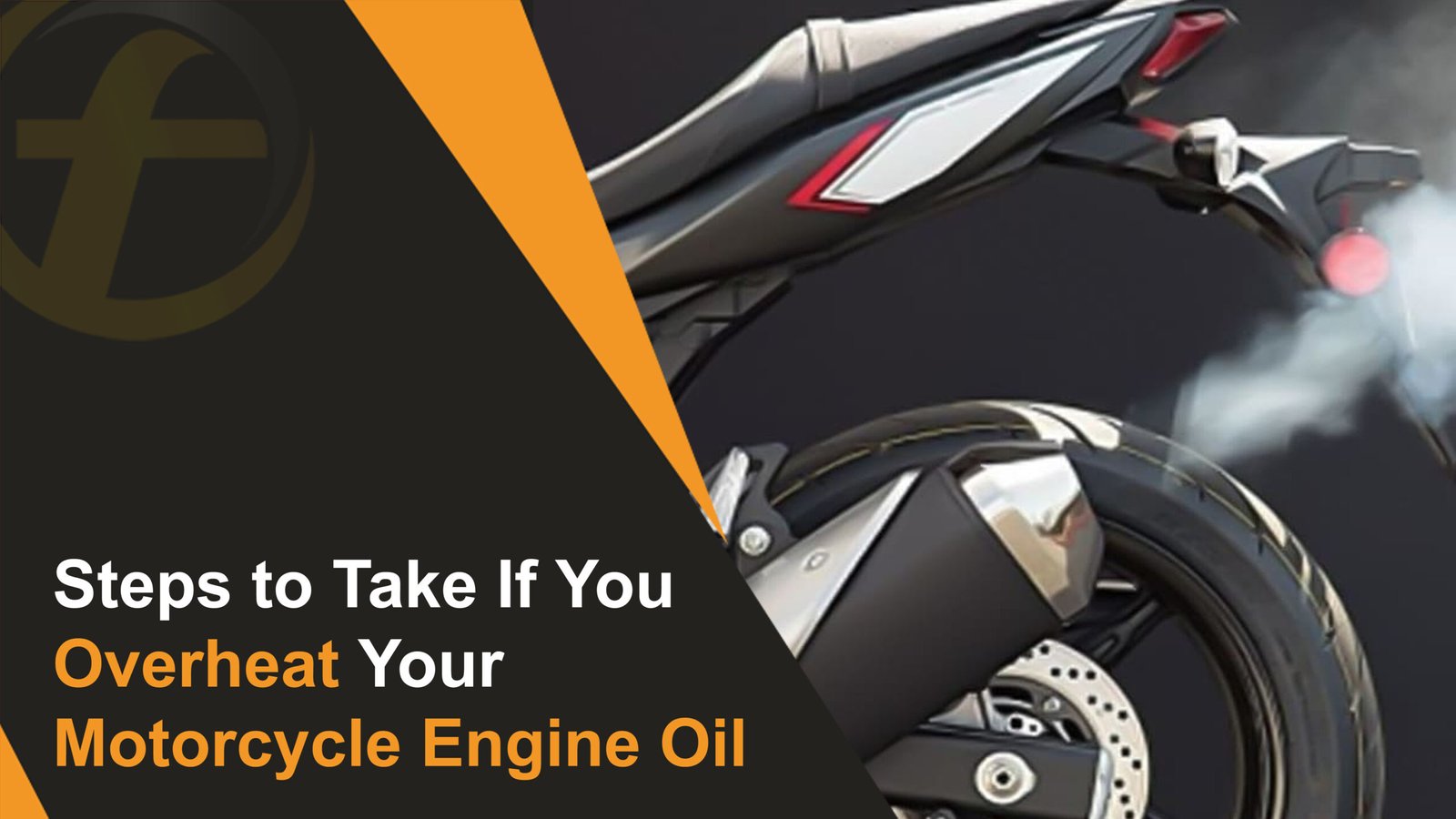
It’s really important to keep your motorcycle engine oil at the right temperature to make sure your bike runs well. If the motorcycle oil gets too hot, it can cause big problems. In this guide, you’ll learn why your motorcycle engine oil might overheat, how to spot the signs, and what to do if it happens. Let’s dive in!
Common Causes of Overheating
Here’s a simple guide on why your motorcycle engine might overheat, how to spot the problem, and what to do about it.
Low Coolant Levels
The problem of overheating can be due to the motorcycle not having enough coolant in its Engine. The coating is like a special compound of fluid that is present in your Engine to ensure it does not get so hot, especially during hot weather.
If you notice that the Engine is hot, it will take about 30 minutes for it to cool up. After that, use your motorcycle manual to identify where the coolant cap is. Some bikes have figured lines for minimum and maximum coolant, and if any of them are visible, it means that the coolant level is low. If so, put more coolant and look for any signs of leakage around the system.
Low Engine Oil
Engine oil facilitates the operating movement of all parts in an engine and prevents it from overheating. In addition to testing the coolant, you also need to check the oil.
This means that if the oil is black and thick or has a dirty appearance, or if new and unusual sounds are coming from the Engine, it must be time to change the oil.
Cooling System Issues
If the coolant is full but the Engine still overheats, there might be a problem with the Radiator or another part of the cooling system. Sometimes, a fan or cooling part might not work right, causing overheating. In this case, you’ll need a mechanic’s help to fix the problem.
Other Engine Problems
Sometimes, other parts like belts and hoses that help move air and coolant around the Engine can cause overheating if they’re not working well. Or, there could be something blocking the system.
Since these problems can be tricky to fix yourself, call a roadside mechanic if your motorcycle engine overheats and you can’t solve it.
For regular maintenance to keep your motorcycle running smoothly, visit Fubex Lubricants!
Signs of Overheating
- Temperature Warning Light or Gauge: Many motorcycles have a temperature light or gauge to show if the Engine is getting too hot. Usually, the gauge stays in the middle, or the light stays off. If the gauge moves into the red area or the light turns on, it means the Engine is heating up too much.
- Steam Coming from the Engine: If you see steam rising from around the Engine, it’s a sign the Engine is too hot. This usually happens because the coolant is boiling. You might see steam near the Radiator or other parts of the Engine.
- Unusual Smells: If you smell something sweet, like syrup, it might mean a coolant leak. Coolant has a sweet smell because of a special ingredient in it. A burning smell could mean that oil, plastic, or wiring around the Engine is getting too hot.
If you notice any of these signs, pull over safely, let the Engine cool down, and check for any problems. For regular engine check-ups, visit Fubex Lubricants to keep your motorcycle running smoothly!
How to Stop Your Motorcycle Engine from Overheating
- Get Regular Check-Ups: Take your motorcycle in for regular check-ups to catch any small problems before they make the Engine overheat.
- Use the Right Coolant: Make sure you use the right type of coolant for your motorcycle, and change it as recommended to keep the Engine cool.
- Watch the Temperature Gauge and Warning Lights: Keep an eye on the temperature gauge and warning lights. If they start to show high heat, stop and check it out.
What to Do if Your Engine Overheats
- Check the Coolant Level: Make sure there’s enough coolant in the system to keep the Engine cool.
- Test the Thermostat: The Thermostat helps control the flow of coolant. Make sure it’s working right.
- Look for Leaks: Check around the Radiator, hoses, and water pump to see if there are any leaks.
- Clear the Radiator: Make sure the Radiator isn’t blocked by dirt or leaves so air can flow and cool the Engine.
- Check the Water Pump: The water pump moves coolant around the Engine. Make sure it’s working well.
- Check the Oil: Ensure there’s enough oil and it’s not dirty to help keep the Engine from overheating.
By following these tips and using Fubex Lubricants products, you can keep your motorcycle engine running smoothly and avoid overheating!
How to Tell if Your Motorcycle Engine is Overheating
All bikes have a temperature warning light; they might use a small thermometer symbol to notify the rider that the Engine’s temperature has risen too high.
Another indication is when you notice a surge of steam rising from around the Engine if this light is not going on. If you should notice either of these, it simply means that you have to stop and take a break!
Signs of Engine Damage from Overheating
If your Engine has already overheated, you might notice:
- Thumping or knocking noises
- Your motorcycle feels slower or less powerful.
- A burning smell
- Smoke or steam
- A very hot engine area
To keep your motorcycle engine cool and running well, follow these tips and trust Fubex Lubricants products for the best engine care!
Immediate Steps to Take
When your motorcycle gets too hot, you need to act fast to avoid damage and stay safe. Here are 8 steps to follow if your motorcycle starts to overheat:
- Pull Over Safely: If you see your motorcycle overheating, find a safe place to stop. Park away from traffic and on level ground if you can.
- Turn Off the Engine: Once you’ve stopped safely, turn off the Engine. This will help it cool down and stop it from getting even hotter.
- Don’t Open the Radiator Cap: Wait for the Engine to cool down before you do anything else. Never open the radiator cap when the Engine is hot because it can let out steam and hot coolant, which can burn you.
- Let the Engine Cool: Give the engine time to cool down. This can take at least 30 minutes or even longer. Use this time to relax and stay safe.
- Check Coolant Levels: After the Engine cools down, look at the coolant tank or Radiator to see if the coolant level is low. If it is, you might leak.
- Look for Leaks: While the Engine is cool, check around the Engine and the ground for any signs of coolant leaks. Leaks can cause the Engine to overheat.
- Call for Help: If you can’t figure out what’s wrong or think there’s a big problem, call for help or a tow truck. A mechanic can help fix the issue.
- Don’t Ride Until It’s Fixed: It’s important not to ride your motorcycle until you know the overheating problem is solved. Riding when it’s too hot can cause serious engine damage.
Remember, acting quickly when your motorcycle overheats can help prevent damage and keep you safe. Checking and maintaining your cooling system regularly can also help stop overheating.
Bottom Line
In summary, taking care of your motorcycle engine oil is key to preventing overheating and avoiding costly repairs. If your engine oil does overheat, remember to act quickly and follow the steps outlined in this guide.
Regular maintenance and using high-quality products, like those from Fubex Lubricants, will help keep your motorcycle in great shape. Stay safe, and happy riding!
FAQs
Q1: Can I continue riding my motorcycle if I notice the engine oil is overheating?
Ans: If your motorcycle is getting too hot, find a safe spot to pull over away from traffic. Turn off the Engine and wait for it to cool down before you look for any problems.
Q2: How long should I wait for the Engine to cool down after overheating?
Ans: After your motorcycle gets too hot, wait at least 30 minutes for the Engine to cool down. It’s even better to wait 1 to 2 hours so it cools down completely.
Q3: What are the potential consequences of not addressing engine oil overheating promptly?
Ans: Not fixing overheating engine oil can cause serious damage and expensive repairs. Ignoring it can lead to loss of power and make your motorcycle harder to ride.

Editor-at-Large
A passionate writer in the lubricant industry, Awais Iqbal has been covering oils, greases, and industrial fluids since the start of his career. At 25, he’s already written for blogs, catalogs, and brand guides across the UAE. Awais’s insights help companies connect with their audience, and his clear, helpful writing style is trusted by brands in the region.


